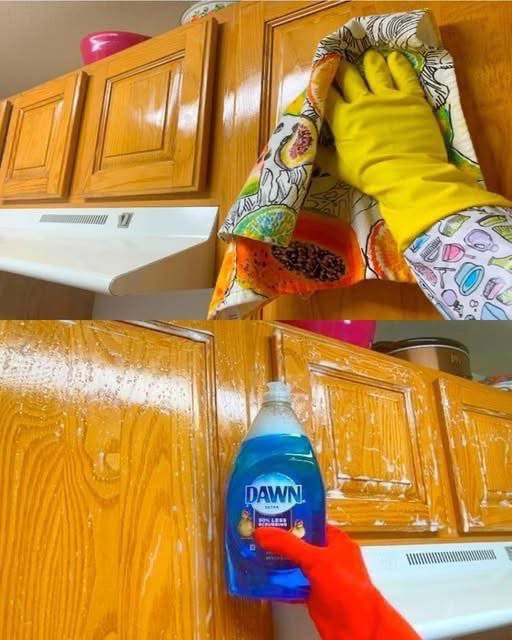Got it 👍 Here’s a long, SEO-optimized post about the genius tip for removing grease from kitchen cabinets that will help you rank well:
🧽 The Genius Tip for Removing Grease from Kitchen Cabinets ✨
A sparkling clean kitchen isn’t just about shiny countertops or fresh floors—it’s also about grease-free cabinets. Over time, kitchen cabinets collect layers of sticky grease and grime, especially near the stove and cooking areas. This buildup not only makes your kitchen look dull but can also attract dust, bacteria, and unpleasant odors.
Fortunately, you don’t need expensive cleaners or harsh chemicals to restore the shine of your cabinets. With one genius cleaning tip, you can easily cut through stubborn grease and bring back the natural beauty of your kitchen.
🔎 Why Do Cabinets Get Greasy?
Every time you cook, tiny particles of oil and steam rise into the air. Even with a range hood or fan, some of that oil settles on nearby surfaces. Over time, it hardens into a sticky layer of grease that’s tough to remove with regular wiping. Wood cabinets, in particular, tend to absorb grease, making the buildup even more noticeable.
🌟 The Genius Tip: Vinegar + Dish Soap Solution
The most effective and affordable way to remove grease from kitchen cabinets is a simple DIY cleaner made with vinegar and dish soap. This natural solution cuts through grease without damaging your cabinets, leaving them fresh and spotless.
🛒 What You’ll Need
- 1 cup warm water
- 1 cup white vinegar
- 1–2 teaspoons dish soap (preferably grease-cutting)
- A spray bottle
- A soft microfiber cloth or sponge
- An old toothbrush (for corners and crevices)
🧼 Step-by-Step Instructions
- Make the Cleaning Solution
- Mix warm water, vinegar, and dish soap in a spray bottle. Shake gently to combine.
- Spray the Cabinets
- Lightly spray the greasy areas of your cabinets. Don’t soak the wood—just enough to dampen the surface.
- Wipe with a Cloth
- Use a microfiber cloth or sponge to wipe in circular motions. You’ll notice the grease starting to lift.
- Tackle Stubborn Spots
- For corners, handles, or textured surfaces, dip an old toothbrush into the solution and scrub gently.
- Rinse & Dry
- Wipe the cabinets with a clean damp cloth to remove any residue. Then, dry immediately with a soft towel to protect the finish.
✨ Extra Tips for Best Results
- Baking Soda for Heavy Grease: Sprinkle baking soda on a damp sponge and scrub problem areas. It acts as a gentle abrasive.
- Olive Oil & Baking Soda Paste: Mix 1 part olive oil with 2 parts baking soda for a natural scrub that works wonders on wood cabinets.
- Regular Maintenance: Wipe down your cabinets weekly with warm soapy water to prevent buildup.
- Avoid Harsh Chemicals: Bleach or ammonia can damage cabinet finishes and should be avoided.
🪄 Natural Alternatives to Try
- Lemon Juice – Natural degreaser with a fresh scent.
- Castile Soap – Gentle yet effective on grease.
- Coconut Oil Polish – After cleaning, a tiny bit of coconut oil can restore shine and act as a protective layer.
🏡 Benefits of a Grease-Free Kitchen
- Makes your kitchen look brighter and cleaner.
- Prevents long-term cabinet damage.
- Reduces odors and bacteria buildup.
- Keeps your kitchen more inviting and hygienic.
✅ Final Thoughts
Greasy kitchen cabinets can make even the cleanest kitchen feel untidy. The good news is, with this genius vinegar and dish soap tip, you can remove grease easily, naturally, and without spending a fortune on store-bought cleaners.
A little consistency goes a long way—if you wipe down your cabinets regularly, you’ll never have to deal with stubborn grease again. A clean kitchen isn’t just about cooking; it’s about creating a space that feels welcoming, fresh, and organized every single day.
